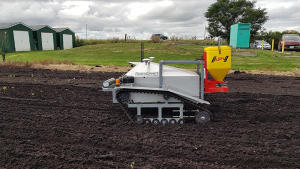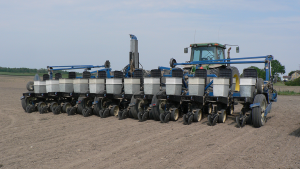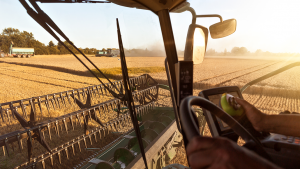Soil health
TESTING AND BUILDING PRODUCTION SYNERGIES

AT THIS POINT, we are all familiar with the term ‘soil health’ and its direct impact on the productivity of our crops. Soil health is a concept that was first recognized in the late 1970s and encompasses chemical, physical, and biological soil indicators. Measuring those indicators — and the factors that affect them — is still ongoing today. There is no scientific consensus on the best indicator, however, as explained by Dr. Inderjot Chahal, a soil scientist and post-doctoral researcher at the University of Guelph, soil organic carbon (SOC) and total nitrogen (TN) are currently well-accepted as solid indicators of soil health.
Much work has been done around the world to study the factors that can increase soil health and the list is quite familiar. They include different tillage systems (no-till versus fall plow), crop rotation, use of cover crops, and N fertility treatments.
In a recent study at the University of Guelph Ridgetown Campus, Chahal (with colleagues Dr. Bill Deen, Dr. Dave Hooker, Dr. Laura Van Eerd, and Dr. Ken Janovicek) assessed the impact of these factors, using data from research plots collected in 2016. They measured how much each can improve soil health, as well as which factors offer the highest capacity for sequestering SOC and TN over time. Their results were just published in Soil and Tillage Research.
Chahal and her colleagues used two commercially available soil health tests called Solvita CO2-burst and Solvita labile amino N (SLAN).
“Solvita CO2-burst and SLAN are indicators of soil microbial activity. Solvita CO2 burst measures the amount of CO2 produced through soil respiration and SLAN measures the amount of emitted NH3,” she says. “Our results confirm the applicability of these tests to detect differences on the scale of crop phase (short-term), and crop rotation and tillage (long-term). To our knowledge, this is the first independent evaluation of SLAN and Solvita CO2-burst as impacted by long-term agricultural management practices such as crop rotation and tillage in a climate like Ontario.”
BENEFITS
In terms of which cropping practices improve soil health more than others, the team’s results suggest that all are important: diversifying the corn-soybean rotation by integrating small grain cereals (winter wheat, oats, and barley), using cover crops such as red clover and/or perennial crops such as alfalfa.
However, Chahal says “I think the most important practice is using cover crops. They provide numerous positive benefits such as increasing soil health, increasing soil carbon storage mainly by adding residue carbon inputs, reducing weed infestation, increasing crop yield, increasing soil microbial activity, and protecting the soil from losses via runoff and erosion. All of these positive influences of cover crops on soil health parameters potentially result in increasing subsequent crop yield.”
Chahal lists the second most-important management strategy to be integrating small grain-cereals such as winter wheat in crop rotations.
“Like cover crops, adding wheat to corn-soybean rotations has shown to be an effective approach for increasing soil diversity, improving soil structure, increasing soil carbon and nitrogen storage, and reducing soil erosion,” she says. “In addition, the presence of living roots of winter wheat during fall, winter, and spring season help to improve soil aggregation and soil structure. This all contributes to improving overall soil health.”
However, if farmers use no-till and therefore hardly disturb the soil (or disturb it very little), this will result in soils with have high carbon storage and improved microbial activity in comparison to conventionally tilled soils.
When asked where no-till ranks with the crop rotation practices listed above, Chahal says “I think it’s more of an additive or a synergistic effect of these management practices on soil and crop parameters. For instance, combination of no-tillage and cover crops is a great option for building soil health and increasing carbon sequestration and this was confirmed in our study.”
In terms of the possible synergistic effect of N application, this nutrient was only applied at Ridgetown’s experimental site.
“We found application of N to corn and winter wheat had no effect on soil organic carbon, and this contrasts with previous findings where N fertilizer increased soil carbon storage due to an increase in biomass production,” Chahal explains. “The gain in soil organic carbon with N fertilizer was numerically greatest in soybean-winter wheat rotation. Similarly, soil microbial activity, as indicated by Solvita CO2-burst and SLAN, was greater when N fertilizer was applied in rotations with winter wheat than without. Our results indicated that application of N fertilizer in monoculture corn and corn-soybean rotation did not increase soil carbon and overall soil health. Therefore, application of N fertilizer alone might not contribute to an increase in soil carbon, but it might increase soil carbon when applied in rotations with winter wheat.”
LEARNINGS
Overall, Chahal would like farmers to understand that soil carbon has a major role in developing resilient cropping systems and that soil carbon status is a valuable predictor of crop yield. However, she notes that “in our study, we did not find a significant relationship between soil carbon and crop yield stability, which suggested that high soil carbon did not increase yield stability.”
That is, because there are numerous soil, crop, and climatic factors which impact the relationship between soil carbon and yield stability, future research is required to confirm the relationship and provide improved recommendations to farmers. Additionally, Chahal says further research synthesizing the interactive effects of N fertilizer, crop rotation, and tillage treatments on soil carbon and nitrogen storage is needed.
She adds that their results are in agreement with previous research, confirming that soil microbial activity has a large influence on soil functioning and agricultural sustainability.
“It’s also been proposed that the mechanism through which the improved land management practices increase soil health might be microbially-mediated,” says Chahal. “This means that quantifying soil biological properties — soil microbial activity, diversity, abundance, and much more — would contribute to improved decision-making related to soil health improvement by the researchers and growers.”
The project was funded in part by the Ontario Agri-Food Innovation Alliance, a collaboration between the government of Ontario and the University of Guelph. •

























